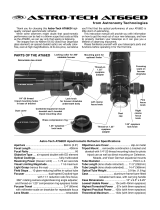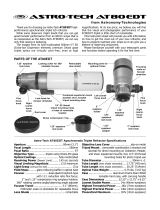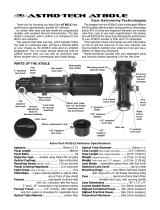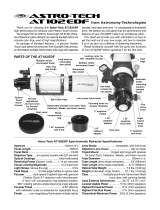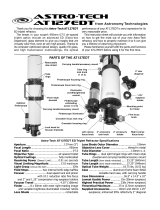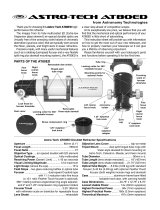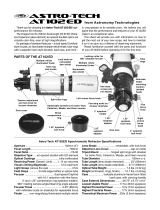Page is loading ...

astro-tech
AT 1 1 1 E D T
from Astronomy Technologies
Thank you for choosing this Astro-Tech AT111EDT
high-quality apochromatic triplet refractor.
The lenses in your scope’s 777mm f/7 air-spaced triplet
optics use Ohara glass exclusively, from Japan’s finest
glass manufacturer. They include an advanced ED (Extra-
low Dispersion) element to give you images that are
virtually color-free, even at very high powers. Thanks to
its computer-optimized optical design, top quality ED
Aperture ............................................ 111mm (4.4”)
Focal Length ...............................................777mm
Focal Ratio ........................................................ f/7
Objective Type.............................. air-spaced triplet
using all-Ohara glass, including an ED element
Optical Coatings ........................... fully multicoated
Resolving Power (Dawes’ Limit) ....... 1.04 arc seconds
Visual Limiting Magnitude .............. 12.7 maximum
Light Grasp (versus the eye) .............................. 251x
Field Stops .......................... three knife-edge baffles
Focuser .......................... dual-speed rack and pinion
with 11:1 reduction ratio fine focus;
360° rotating camera angle/observing angle adjuster;
and 2” and 1.25” compression ring eyepiece holders
Focuser Travel ................................. 5.4” (138mm);
millimeter scale on drawtube for repeatable focus
glass, and high transmission multicoatings, the optical
performance of your AT111EDT is exceptional indeed.
This instruction sheet will provide you with information
on how to get the most out of your new Astro-Tech
refractor, and how to properly maintain it so it can give
you a lifetime of observing enjoyment.
Please familiarize yourself with the parts and functions
of your AT111EDT before using it for the first time.
Astro-Tech AT111EDT Apochromatic ED Triplet Refractor Specifications
Finder .............. optional; mounting shoe provided for
Astro-Tech multiple reticle finder or similar finder
Lens Shade ............................................ retractable
Lens Shade Outer Diameter .......................150mm
Objective Lens Cover .........................slip-on metal
Tube Diameter .................................... 124mm o. d.
Tube Length (lens shade retracted).....23.75” (603mm)
Tube Length (lens shade extended) ........ 28” (711mm)
Optical Tube Weight................. 14.65 lbs. (6.66 kg)
Case ............................. aluminum-frame foam-fitted
lockable hard case, with carrying handle
Case Dimensions .......................... 28” x 10.25” x 9”
Lowest Usable Power ......... 19.4x (40mm eyepiece)
Highest Terrestrial Power .......86x (9mm eyepiece)
Highest Practical Power ........ 194x (4mm eyepiece)
Theoretical Maximum ........ 222x (3.5mm eyepiece)
Retractable dew shield
Lock knob for
focuser drawtube
Locking knob for 360°
rotatable focuser
PARTS OF THE AT111EDT
Left coarse
focus knob
Fine
focus
knob
Focusing
scale on
focuser
drawtube
1.25”
eyepiece
holder
1.25” eyepiece
lock knob
Dust cover
1.25” eyepiece
lock knob
Brass compression ring
Right
coarse
focus
knob
1.25”
eyepiece
holder
Mounting shoe for
optional finder
2” eyepiece
lock knob
2”
eyepiece
holder
2”
eyepiece
holder
1.25”
eyepiece
holder

astro-tech
www.astronomytechnologies.com
from Astronomy Technologies, 680 24th Avenue SW, Norman, OK 73069
© 2008 by Astronomy Technologies Specifications, features, and descriptions are effective 1/1/2008, but are subject to correction and/or modification without notice and/or obligation.
Your Astro-Tech AT 11 1 EDT refractor can be used for day and
night viewing by simply adding a star diagonal and eyepiece. Any
brand of eyepiece can be used, from a 40mm for the lowest practical
magnification (19.4x), to a 3.5mm (222x) for very high power use. A
2” eyepiece holder on the focuser drawtube and the supplied 1.25”
eyepiece adapter let you use either 1.25” or 2” star diagonals and
eyepieces with no other adapter needed.
The focal length of the AT111EDT is ideal for low to medium power
wide-angle views of nebulas, open star clusters, large galaxies, and
comets. Crisp views of the Moon and planets are also routine at
magnifications of 111x to 194x when seeing conditions permit.
To calculate the magnification of your telescope and eyepiece
combination, divide the telescope focal length in mm by the eyepiece
focal length in mm. For example, a 7mm eyepiece in the AT111EDT
will give you a magnification of 111x (777mm/7mm = 111).
Mounting the AT111EDT: A stable mount is essential for best
viewing. The scope is not supplied with mounting rings, but machined
124mm i. d. split rings are readily available from your Astro-Tech
dealer. These will allow you to install your scope on an equatorial
mount of your choice for extended astronomical observing. Adding
an optional Vixen-style dovetail bar to the rings will let you mount
your AT111EDT on a suitably-sturdy altazimuth mount for terrestrial
observing and casual grab-and-go backyard astronomy.
Astro-Tech makes an exceptionally stable altazimuth mount, the
Astro-Tech Voyager, that can easily support the 14.65 lb. AT111EDT.
The adjustable-height Voyager has automatic-clutch worm gear manual
slow motion controls in both altitude and azimuth to make tracking
terrestrial and astronomical objects smooth and easy.
Astronomical Observing: The theoretical maximum usable power
available from this telescope is 222x, although this requires a 3.5mm
eyepiece that provides a very dim 0.5mm diameter exit pupil. Higher
powers
are
within the scope’s capabilities, but require truly excellent
seeing conditions and the patience to wait for those conditions to
make their brief and infrequent appearances.
A more practical maximum magnification for astronomical viewing
with the AT111EDT would be 194x, using a 4mm eyepiece. Keep in
mind that seeing conditions play an important role in how high a
magnification you can use on any given night. Only very good seeing
conditions (clear skies and calm air) will support viewing at 194x.
Under less than ideal conditions, lower powers in the 111x to 130x
range provide more consistently usable and pleasing images.
The widest possible field of view with a 1.25” eyepiece is about
2.2°, which can be achieved with a 19.4x (40mm) Plössl eyepiece
yielding a 5.71mm exit pupil. A 2” wide field eyepiece, such as the
40mm TMB Paragon, will give a 3.5° field at the same 19.4x power.
The AT111EDT does an outstanding job as a wide-field astrograph
for 35mm and CCD imaging. A large chrome lock knob on top of the
scope barrel lets you lock the position of the extra-long 138mm travel
rack and pinion focuser drawtube at a sharp focus for photography.
Rotating the Focuser: The focuser’s 2” eyepiece/accessory holder
can be rotated a full 360° for the best photographic composition, or
to put your star diagonal in the most comfortable observing position.
To rotate the eyepiece holder, loosen the chrome lock knob on the
telescope barrel just in front of the 2” eyepiece/accessory holder and
rotate the holder to the desired angle. The indentations around the
eyepiece holder provide a non-slip grip to make adjusting the angle
easier. Tighten the lock knob to temporarily lock the eyepiece holder
at the new angle.
Terrestrial Observing: The AT111EDT works well for daytime
birding, nature studies, sweeping the landscape from the home with
a view, etc. – provided it is installed on a suitably sturdy tripod or
altazimuth mount, such as the Astro-Tech Voyager. It is also an excellent
flat-field 777mm (15.5x) f/7 telephoto lens for terrestrial photography.
Generally speaking, the maximum usable daytime power with any
terrestrial scope is about 1x per mm of aperture (theoretically 111x
with the AT111EDT). However, attempts to push the daytime power
to this high a magnification often magnify the heat waves, dust, and
“mirage” in our atmosphere to the point where the images become
blurry and unusable. A 22x (25mm) to 69x (8mm) eyepiece is usually
more satisfying for everyday terrestrial use than a 111x eyepiece.
Optional Astro-Tech Accessories: Astro-Tech makes 1.25” and
2” star diagonals with state-of-the-art 99% reflectivity dielectric
coatings that nicely complement the performance of the AT111EDT.
These diagonals are available from your Astro-Tech dealer to provide
the maximum possible contrast and planetary detail. An Astro-Tech
45° viewing angle image-erecting 1.25” diagonal is available for
terrestrial observing. An inexpensive Astro-Tech illuminated non-
magnifying multi-reticle finder is also available for your AT111EDT.
Collimating Your Optics: See the supplied separate collimation
sheet for information on collimating the lens for peak performance.
Caring for Your Scope Optics: Never store the telescope in a
damp or humid environment. Avoid leaving it in a hot environment
(exposed to direct sunlight on a window sill, in a car trunk, etc.) If
you must store it in high humidity conditions, put a few packets of
desiccant (silica gel or the equivalent, available from most camera
stores) in with the telescope to absorb excess moisture. If not properly
stored in a humid environment, the telescope may develop mildew
which can damage the optics.
If dew has formed on the scope after a night of observing, allow
the scope optics to air dry at room temperature before putting the
lens cover on the scope and storing it away.
If the lens becomes dusty, smeared, or shows fingerprints or any
other surface build-up, clean it as follows. First, gently blow away any
surface dust or particles with a clean air blower (a child’s ear syringe
or a photographer’s camel’s hair brush with attached blower bulb, for
example). Using canned or compressed air is not recommended, as
the propellant in the can may spit out and leave difficult-to-remove
deposits on the lens. Also, the expanding compressed air drops in
temperature as it leaves the can. The cold air coming out of the tiny
tube that most compressed air cans use to direct the air flow has
been known to chill a lens enough to spall pieces of glass off the lens
if pointed too closely at the same spot on the lens for too long.
Second, moisten a cloth with a few drops of a photographic-quality
optical cleaning solution designed for multicoated camera and binocular
lenses. A well-worn cotton handkerchief works well and Zeiss and
Kodak both make suitable fluids. Do not drip the cleaning fluid directly
on the lens. Use the barely damp (not wet) cloth to gently wipe the
lens surface clean. Turn the cloth frequently to always keep a clean
portion of the cloth in contact with the lens. Blot the lens dry with a
dry portion of the cleaning cloth or with a separate cloth. Start with a
clean cloth each time cleaning is needed.
Avoid overcleaning your optics. The multicoatings on the lens are
quite hard and durable. However, frequent overzealous cleaning can
scratch the coatings if all the dust particles (which are often tiny
flecks of windborne rock) are not removed before you start pushing a
damp cloth around the lens surface. A few specks of dust on the lens
will not be visible in your images, as they are not in the focal plane
and don’t block enough light to measure, let alone be seen. Clean
your optics only when absolutely necessary. If you take proper care
of your scope, cleaning should rarely be needed.
Caring for Your Scope Finish: The AT111EDT uses a durable
automotive-style baked paint finish with anodized components. The
surfaces can become smudged with fingerprints during use, but these
will not harm the finish. A soft cloth slightly dampened with plain
water (or a little moisture from your breath and a quick wipe with a
clean handkerchief) is generally enough to remove fingerprints. Avoid
harsh chemical cleaners or organic solvents like benzene, alcohol,
etc., as these may ruin the finish. They can certainly affect the optical
coatings if they accidentally drip or splash on the objective lens.
Never use the telescope in the rain or in conditions where it may
get wet. The telescope is not waterproof. If the telescope accidentally
gets caught in a shower, immediately wipe off all water using a clean
and dry soft cloth. If the telescope gets totally soaked in water, or
submerged, immediately contact your dealer for service instructions.
Do not disassemble or attempt to repair your telescope yourself, as
this violates the warranty terms under the limited product warranty,
and negates any guarantee.
Caution! Never directly view the Sun with your telescope!
Never aim your AT111EDT at the Sun without having a professionally-
manufactured solar filter mounted over the objective lens. Viewing
the Sun through the scope without the proper protection for even a
moment may result in permanent severe damage to your eyes, and
can even cause blindness. Contact your Astro-Tech dealer if you are
interested in purchasing a compatible professional solar filter.
/

